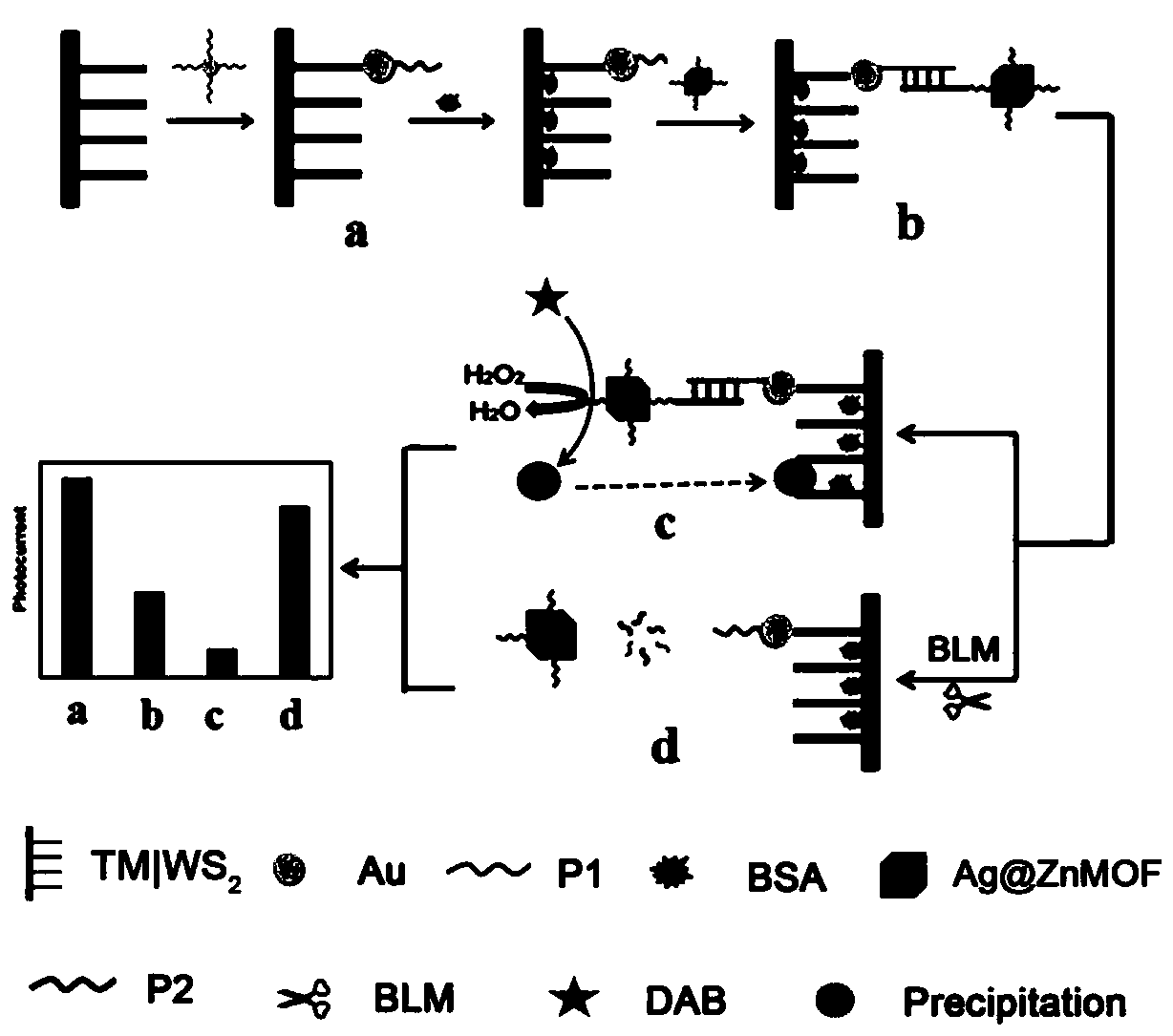Photoelectrochemical biosensor and detection method thereof for BLM (bleomycin)
A biosensor and photoelectrochemical technology, applied in the direction of chemiluminescence/bioluminescence, material electrochemical variables, scientific instruments, etc., can solve the problems of reducing active sites and adsorption capacity, and achieve improved catalytic activity, good stability, and electrolyte diffusion good sex effect
- Summary
- Abstract
- Description
- Claims
- Application Information
AI Technical Summary
Problems solved by technology
Method used
Image
Examples
Embodiment 1
[0042] (1) Add 0.8g Na 2 WO 3 2H 2 O was dissolved in 18 mL of deionized water, and HCl was added dropwise to adjust the pH to 1.1. 0.8g H 2 C 2 o 4 Add to the above mixture, dilute to 45 mL and stir at room temperature. Subsequently, a total of 0.8 g NH 4 Cl and 0.8 g of thiourea were dissolved in the above mixture, respectively. Clean the TM by sonicating in water and ethanol for 8 min. The pretreated titanium mesh (TM) (2 × 4 cm) and the above solution were transferred into a 50 mL Teflon-lined stainless steel autoclave and kept at 170 °C for 15 h. After cooling to room temperature, the product was washed three times with ultrapure water. Subsequently, the sample was placed under flowing N 2 It was heated at 440° C. for 0.8 hours in an atmosphere. Then get WS 2 / TM.
[0043] (2) Add 0.8mL HAuCl 4 (22mM) solution was added to 98mL distilled water and boiled. Then, 1.9mLNa 3 C 6 h 5 o 7 2H 2 O solution (67mM) was quickly added to HAuCl 4 In the boiling so...
Embodiment 2
[0047] (1) Add 0.9g Na 2 WO 3 2H 2 O was dissolved in 22 mL of deionized water, and HCl was added dropwise to adjust the pH to 1.3. 0.9g H 2 C 2 o 4 Add to the above mixture, dilute to 45-50 mL and stir at room temperature. Subsequently, a total of 0.82 g NH 4 Cl and 0.84 g of thiourea were separately dissolved in the above mixture. TMs were cleaned by sonication in water and ethanol for 12 min. The pretreated titanium mesh (TM) (2 × 4 cm) and the above solution were transferred into a 50 mL Teflon-lined stainless steel autoclave and kept at 190 °C for 17 h. After cooling to room temperature, the product was washed three times with ultrapure water. Subsequently, the sample was placed under flowing N 2 It heated at 460 degreeC for 1.2 hours in atmosphere. Then get WS 2 / TM.
[0048] (2) Add 1.2mL HAuCl 4 (26mM) solution was added to 100mL distilled water and boiled. Then, 2.1mLNa 3 C 6 h 5 o 7 2H 2 O solution (69 mM) was quickly added to HAuCl 4 In the boil...
Embodiment 3
[0052] (1) Add 0.85g Na 2 WO 3 2H 2 O was dissolved in 20 mL of deionized water, and HCl was added dropwise to adjust the pH to 1.2. 0.85g H 2 C 2 o 4 Add to the above mixture, dilute to 48 mL and stir at room temperature. Subsequently, a total of 0.81 g NH 4 Cl and 0.83 g of thiourea were separately dissolved in the above mixture. Clean the TM by sonicating in water and ethanol for 10 min. The pretreated titanium mesh (TM) (2 × 4 cm) and the above solution were transferred into a 50 mL Teflon-lined stainless steel autoclave and kept at 180 °C for 16 h. After cooling to room temperature, the product was washed three times with ultrapure water. Subsequently, the sample was placed under flowing N 2 It heated at 450 degreeC for 1.0 hour in atmosphere. Then get WS 2 / TM.
[0053] (2) Add 1.0mL HAuCl 4 (22-26mM) solution was added to 99mL of distilled water and brought to a boil. Then, 2.0mLNa 3 C 6 h 5 o 7 2H 2 O solution (68 mM) was quickly added to HAuCl 4 I...
PUM
| Property | Measurement | Unit |
|---|---|---|
| size | aaaaa | aaaaa |
Abstract
Description
Claims
Application Information
 Login to View More
Login to View More - R&D
- Intellectual Property
- Life Sciences
- Materials
- Tech Scout
- Unparalleled Data Quality
- Higher Quality Content
- 60% Fewer Hallucinations
Browse by: Latest US Patents, China's latest patents, Technical Efficacy Thesaurus, Application Domain, Technology Topic, Popular Technical Reports.
© 2025 PatSnap. All rights reserved.Legal|Privacy policy|Modern Slavery Act Transparency Statement|Sitemap|About US| Contact US: help@patsnap.com



